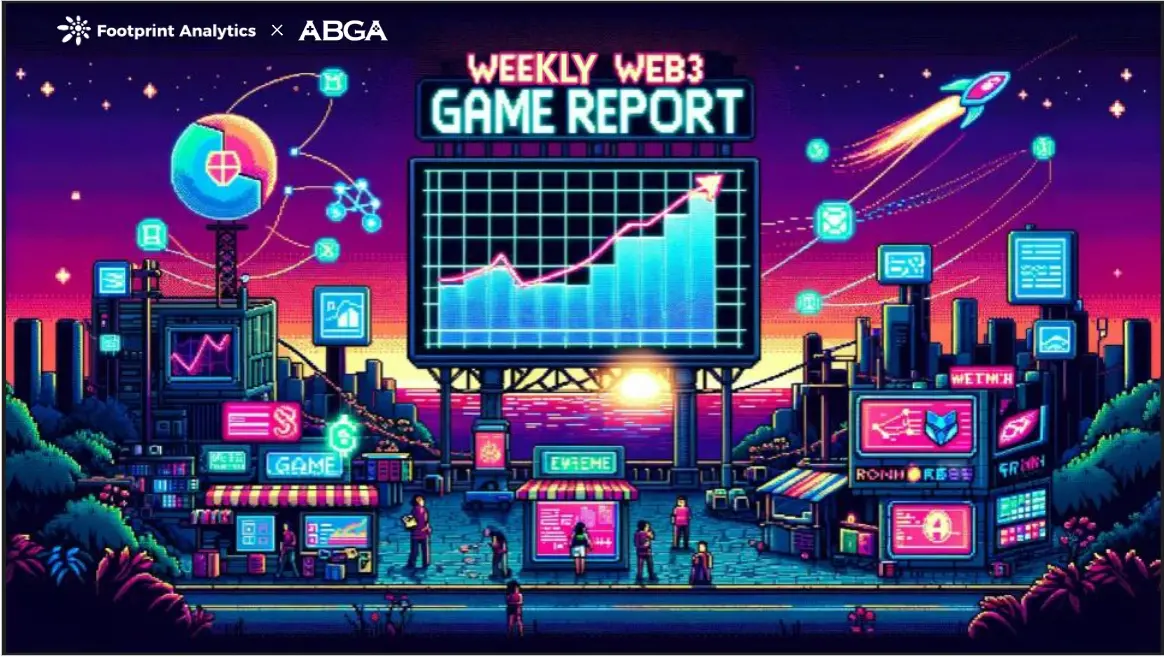Redefining GameFi, will TreasureDAO become the Nintendo of the crypto world?
*Author: Daniel Li, *CoinVoice
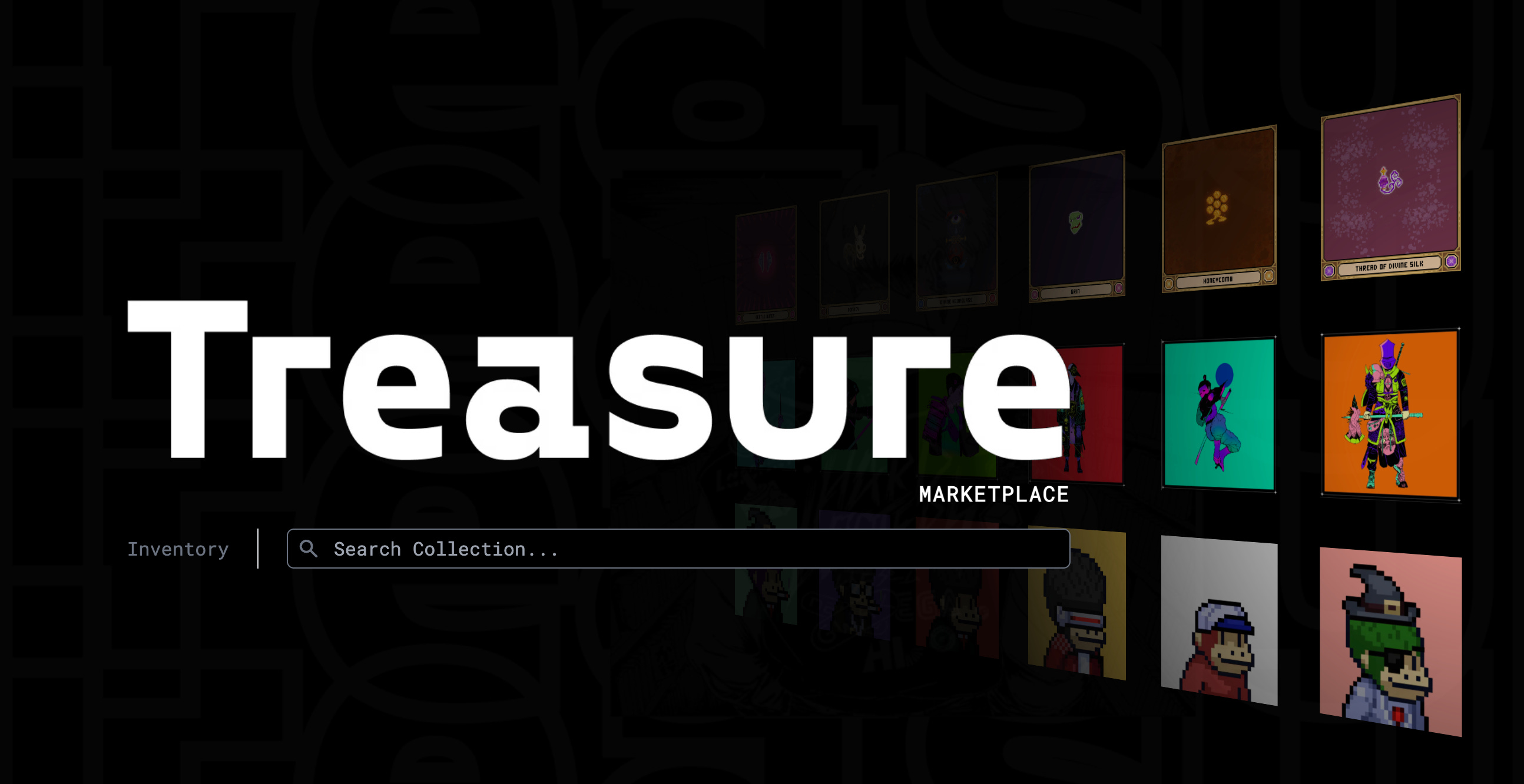
Treasure is a phenomenal project in the blockchain gaming sector, having incubated over 10 games, including the recently viral The Beacon on social media. This simple pixel-style blockchain game has sparked rare excitement in the currently quiet GameFi market due to its unique dungeon attributes.
According to data on Dune, within just one week of its launch, The Beacon's player count nearly broke 20,000, with 30,000 purchases of the game's genesis character NFTs. The series of characters and equipment generated in The Beacon are priced in Treasure's token MAGIC. The attention brought by the game's popularity has strengthened market confidence and expectations for MAGIC, which has risen by 300% in the past month. As of now, the price of MAGIC is $2.01, ranking 79th by market capitalization.
Constant Exploration of Treasure
Treasure initially started as an NFT project within the Loot ecosystem, called Treasure NFT. Loot is a series composed of 8,000 NFTs, each NFT being a TXT file made up of 8 phrases, with each phrase representing a randomly generated attribute (such as weapons, chest armor, helmets, necklaces, rings, etc.) with varying degrees of rarity.
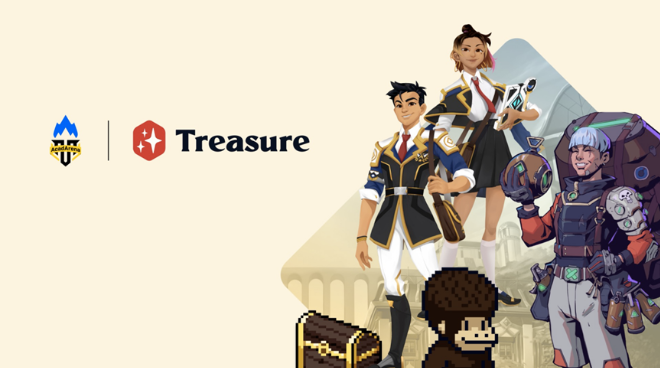
As a derivative project of Loot, Treasure borrowed ideas from Loot's development, creating a set of phrases as NFTs, but these phrases represent historical and legendary currencies such as gold coins, silver pennies, emeralds, pearls, shells, and dragon tails. At this point, Treasure had no distinguishing features or advantages compared to other Loot clones, but it managed to survive and thrive among numerous Loot clone projects, thanks to its relentless exploration of future development.
Shortly after issuing NFTs, Treasure launched the MAGIC token and tailored a DeFi project for MAGIC—MAGIC Farm. Users can earn MAGIC token rewards simply by depositing Treasure's NFTs, Loot's NFTs, or AGLD tokens. Treasure aimed to provide incentives for ecosystem development through the combination of blockchain gaming and DeFi, announcing the development of a Legions blockchain game, with MAGIC as the in-game token. Unfortunately, this approach did not achieve the expected results. However, during this attempt, Treasure discovered a new model—the MAGIC ecosystem.
MAGIC, as Treasure's native token, is the sole currency for transactions within the Treasure market. Each community within the Treasure ecosystem constructs its own narrative around the MAGIC token, linking narrative and economic ecology through MAGIC, which also serves as the reserve currency connecting the entire Treasure ecosystem. From then on, Treasure officially began to build around empowering MAGIC, continuously creating blockchain games to attract more external blockchain games or other projects, all of which require the consumption of the platform token MAGIC, ultimately forming an ecosystem centered around MAGIC.
With the increase in community members and the development of ecological projects, the Treasure team launched TreasureDAO as a new governance body for the Treasure ecosystem. The original Treasure NFTs became a part of history, and now everything operates under the identity of TreasureDAO. TreasureDAO holds the team's rights (such as the distribution plan for MAGIC, which projects to incubate within the ecosystem, etc.) and is the sole recipient of MAGIC incentives, managed by holders of staked MAGIC through voting. The success of Treasure can be attributed significantly to the key role played by TreasureDAO.
Treasure Redefines GameFi
GameFi refers to a new collection of blockchain-based games that combine the fun of gaming with economic incentives (earning money through gaming), allowing players to earn rewards (NFTs or tokens) during gameplay. An ideal GameFi ecosystem allows players to own all their in-game assets as well as their ecosystem. Play-to-Earn (P2E) games are not a new concept, but by integrating blockchain composability, GameFi elevates P2E to a new level.
The key to GameFi's success lies in liquidity. Most players join projects primarily to earn profits rather than simply enjoy the game, as Web3 games still lag far behind mature Web2 games in terms of entertainment value. Unfortunately, most GameFi development teams remain stuck in the game development mindset of the Web2 era, with economic designs still relying on increasing APY (%) or airdropping tokens to attract user attention. While this approach can yield good short-term results, it has proven unsustainable in the long term. Once users discover low returns, their attention quickly shifts elsewhere, leading speculators to sell off tokens and liquidity to vanish.
TreasureDAO recognized this early on and provided a new perspective: to make liquidity the core objective of the game. Treasure's goal is to create a community-driven game centered around liquidity, positioning the native token MAGIC as a resource supporting the ever-growing metaverse and gaming network. Treasure DAO uses MAGIC to guide the new metaverse and increase its utility by weaving it into multiple game narratives. With MAGIC, GameFi projects no longer need to build vast game worlds to capture attention through rich narratives and complex in-game economies. Instead, they can create conventional games that people enjoy, using MAGIC as their base currency. Through MAGIC, Treasure unlocks the ability to capture user attention, as it can transfer from one game and community to another, enabling user assets to cross between different games.
TreasureDAO's ultimate goal is to become the Nintendo Switch of the Web3 world. In the future, MAGIC will represent a stake in an ecosystem that encompasses an entire vertical of NFT and gaming products, which are interconnected and mutually constructed. Just like LEGO bricks, any new or existing game can be plugged into the Treasure ecosystem and enjoy the benefits of MAGIC, the market, and the community.
Important Ecological Projects of Treasure
Currently, Treasure's ecosystem includes a governance body (TreasureDAO), several game metaverses and NFT projects, and a marketplace (Trove). TreasureDAO and Trove are the core components connecting all parts, while Bridgeworld is where Treasure issues and acquires MAGIC.
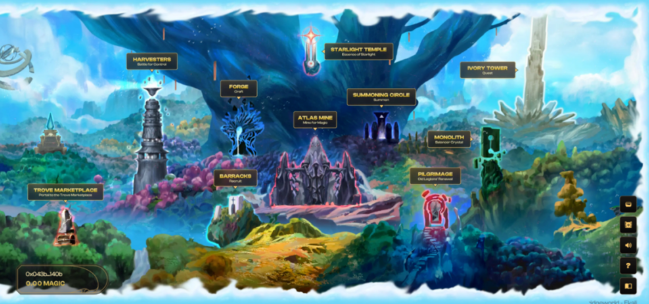
Trove
Trove is an NFT marketplace built for the metaverse within and around the Treasure ecosystem. It is positioned as the OpenSea on Arbitrum, serving all NFT projects on Arbitrum, priced in ETH.
Trove is associated with projects being built within the TreasureDAO ecosystem (games and infrastructure), and its interwoven gamified mechanisms will help attract more attention and interest, while also rewarding loyalty through badges and achievement systems, leaderboards, EXP, user levels, and more. Trove users holding Balancer Crystals (gamified MAGIC-ETH LP tokens) will be eligible for in-depth collectible-level data, including historical trading volumes, floor price changes, collection scores, etc. These initiatives have significantly contributed to user retention.
Bridgeworld
Bridgeworld is a strategic business, trade, and domination game, but it should be regarded more as a gaming platform. Bridgeworld integrates many DeFi elements, forming the foundational economic layer of TreasureDAO, and serves as an important structure connecting other game worlds within the ecosystem.
Bridgeworld introduces a unique gameplay mechanism. Unlike P2E, which attracts players by issuing tokens, players in Bridgeworld must "work" (play the game) to earn rewards. The more time and effort players invest, the more MAGIC rewards they receive. This design permeates Bridgeworld, where the effort and time spent indirectly validate the value of NFT assets within Bridgeworld.
MagicSwap
MagicSwap plays a crucial role in the Treasure DAO ecosystem. It is the most powerful DEX within the Treasure DAO ecosystem. Currently, the exchange only allows trading of two token pairs: MAGIC/Gfly (Gfly as the governance token for BattleFly DAO) and MAGIC/ELM (ELM as the governance token for Tales of Elleria).
Treasure DAO plans to launch MagicSwap V2 NFT Automated Market Maker (AMM) in the second quarter of 2023. Treasure has designed a new and improved trading method, making it the first AMM in cryptocurrency to support ERC-20 and NFT pools through a single router, allowing trading of all projects within the gaming economy. This tool is expected to potentially revolutionize the Web3 gaming economy.
Popular Games Incubated by Treasure
TreasureDAO has currently incubated over 10 games, including The Beacon, BattleFly, Tales of Elleria, The Lost SamuRise, Realm, and others.
The Beacon
The recently popular game The Beacon was incubated by TreasureDAO. The Beacon is a fantasy action game that incorporates Roughlite elements. Players can obtain characters for free or for a fee, then venture into dungeons or answer questions in taverns, both of which can yield item drops. Items dropped from paid characters can be sold for profit.
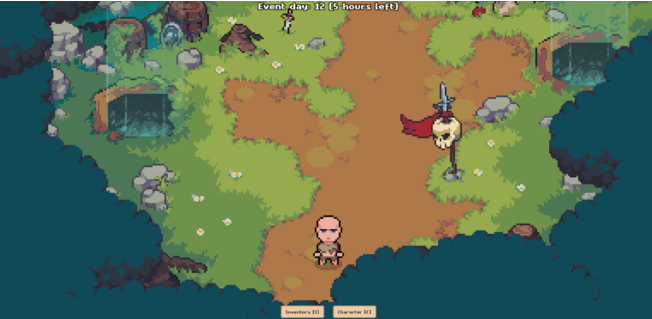
The Beacon launched on Arbitrum just one week ago, and without any promotional activities from the official side, the player count nearly broke 20,000, with over 30,000 purchases of the game's genesis character NFTs. The popularity of The Beacon has also driven up Treasure's data. According to Dune's data dashboard, the daily active users in the Treasure ecosystem rose from around 1,500 to about 6,000, with new users increasing by an average of 2,000 daily. The series of characters and equipment generated in The Beacon are also priced in the TreasureDAO token MAGIC, and the game's popularity has led to a surge in MAGIC, which has tripled in price over the past month.
BattleFly
BattleFly is considered the first high-capacity, mass-market game in the TreasureDAO ecosystem, designed to minimize the impact of inflation and speculation on core gameplay. As an experimental PvP (player versus player) strategy game, players can compete against each other for rewards. Players will earn TreasureDAO's MAGIC token rewards, which serve as the main currency in the game.
In Season 1 of BattleFly, two different levels of strategy games were introduced: the Trial Grounds and the Super Dome. The Trial Grounds is where new BattleFlys learn skills and can only match with beginners or new BattleFlys. Everyone must start here and prove themselves in battle. The Super Dome is the real competition, where BattleFlys engage in fierce competition, with higher rankings yielding more MAGIC rewards.
Tales of Elleria
Tales of Elleria (TELL) draws its GameFi inspiration from the off-chain RPG (ranking game) of Final Fantasy. The project was initially developed for BSC but was migrated to Arbitrum after community voting.
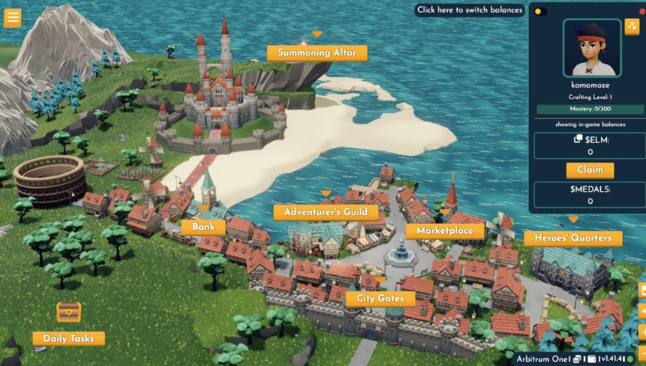
TELL aims to become a decentralized GameFi project, providing an immersive and engaging gaming experience packaged with DeFi elements. In the future, TELL will open as a single continent, with game development and design entirely written and owned by the community. Additionally, Tales of Elleria is also developing and testing an open-world version of Elleria, which will serve as a bridge between different projects, achieving complete immersion and appropriate real-time skill gaming through the integration of resources from various projects.
Lost SamuRise
The Lost SamuRise is a faction-based strategy game set in a fictional world of paradise, drawing on elements of Japanese classical samurai culture and legends.
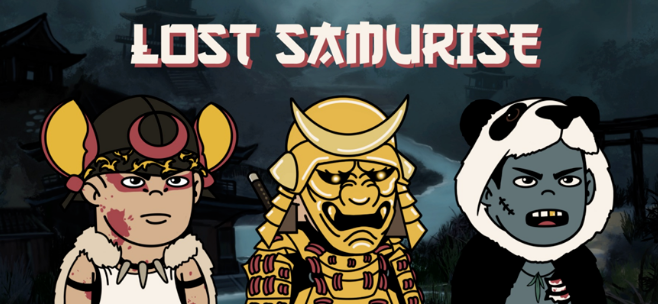
In SamuRise, there are three factions, each containing three provinces. The factions organize themselves in SamuRise to wage resource wars, with the victorious faction gaining the right to become the shogunate. The game's assets are land, and each Ethereum wallet address can only generate one piece of land. As long as players successfully complete the "Sanctuary Mission," they can permanently allocate that land parcel to a faction.
LifeVerse
LifeVerse is a simulation game built on the TreasureDAO ecosystem, designed to allow players to experience a different life.

Players' journeys begin with the Seed of Life, which can be exchanged for a newborn assigned to one of eight different character categories. Players can choose one. The rarity of characters varies, playing different roles in the development of the player's life form, most notably in the amount of MAGIC earned during employment. As the life form of the game character grows, its physical state evolves. To promote growth and maximize output, nutrients must be supplied to the game character's life form; without nutrient supplementation, the life form will deteriorate or even perish. LifeVerse turns anthropomorphized life forms into NFTs, and when that life form ends, players can purchase a Seed of Life on Trove to reshape a new life.
Conclusion
Treasure's long-term goal is to become the Nintendo of the crypto metaverse. To this end, Treasure is set to launch MagicSwap V2 NFT Automated Market Maker (AMM) in 2023, which can support ERC-20 and NFT pools through a single router and facilitate trading of all projects within the gaming economy. Furthermore, Treasure is building a decentralized gaming ecosystem around its native token MAGIC, incorporating shared assets, resources, communities, and infrastructure. Treasure is making steady progress toward its goal.






